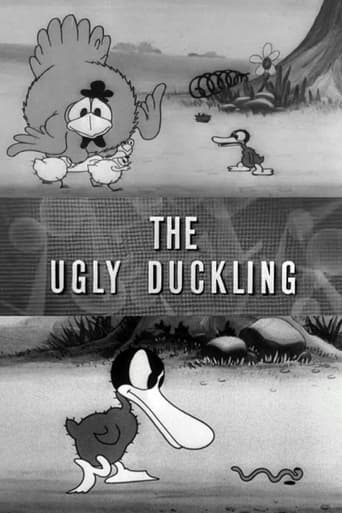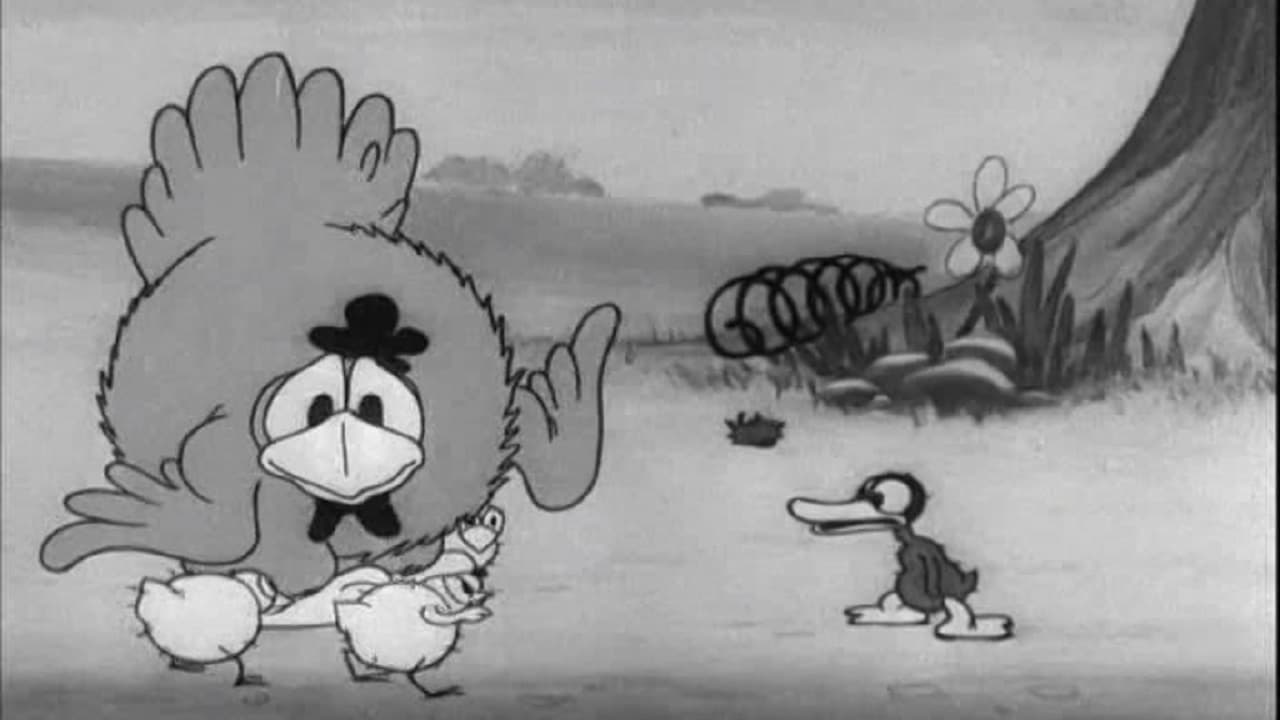bellino-angelo2014
Always loved the 1939 color version, but this version is also cute and lovable to watch. It's a bit different even from the source material, the Hans Christian Andersen fable.It begins in a hen-house, with a chicken that hatches 6 chicks and a duckling. When he discovers the duckling, he marginalisez it. But when a tornado comes, almost destroying the farm, the duckling saves the chicks and then mother chicken accepts him in his family.The animation is quite good for 1931 standards, as is still in black-and-white, but still likable, especially in the tornado sequence, and all the animals here are very cute, especially the chicks and the duckling. Also the music is quite good. And the duckling is so unlucky that you will root for him! Recommended to all fans of old animated shorts.
OllieSuave-007
This is a touching Silly Symphony cartoon from Walt Disney - a retelling of Hans Christian Anderson's tale, The Ugly Duckling. Here, a mother hen hatches some chicks, but one turns out to be an ugly duckling; therefore, it is immediately repulsed.The ugly duckling was actually pretty adorable and will immediately grab your sympathy and heart as you see him try to get along with his new family. But, the poor thing couldn't catch a break and deemed to remain lonely. However, that is until he might prove a sense of belonging by braving through a tornado to save his siblings. It's a satisfying sight seeing that even an outcasted creature could be brave enough to save those who once ignored him.A great little cartoon with a great message.Grade A-
Shawn Watson
This primitive 1931 black-and-white cartoon is based on the old fable of the unattractive child who grows up to be beautiful and spits in the face of all those who previous laughed and avoided them. After all, society SHOULD cast out those who are different as anything other than normal is frightening.Of course the duckling turns out to be a swan who somehow ended up in the nest of a mother hen (not duck). It's a fable that has been drilled into the subconscious of most children in the developed world, yet most of them do still grow up to reject what is different.During a storm the ugly one rescues the other chicks and is accepted.Although I mentioned that the duck is actually a swan, it isn't. It's actually a duck, while the others are actually baby chickens. So the entire premise of the cartoon is false.
wmorrow59
During the ten-year period when Disney animators produced their delightful Silly Symphony series, Hans Christian Andersen's "The Ugly Duckling" was the only story they chose to dramatize twice. The studio released two quite different versions of the story in 1931 and 1939, at the beginning of the series' history and at the end. The later adaptation displays all the sophisticated techniques the crew had developed during that eventful era: it's in glorious Technicolor, the draftsmanship and character animation are superb, and the storytelling is clear, concise, and funny. And yet there's something to be said for the comparatively primitive black & white version of 1931. For one thing, and whatever the animators' intentions may have been, it appears to be a deliberate condemnation of racial prejudice in the form of a parable.That might sound like a stretch, but the evidence is there, first in the design of the characters and second in their behavior. When the film begins we see a mother hen sitting on her eggs, and when they begin to hatch several identical chubby chicks appear; because the film lacks color, the chicks are solid white. Then the duckling hatches, and we are startled to find he resembles a caricature of a 19th century minstrel performer: his body is grayish but his head is solid black, except for his eyes and his large white bill. While his sibling chicks emit high-pitched peeps, his voice is an earthy sounding honk, rather like a jazz trumpeter. Instantly the mother hen is horrified at the sight of him, and ushers her chicks away. The duckling is dismayed at this rejection, and from then on strives to prove himself worthy of acceptance.In the studio's later adaptation this element of prejudice can be found as well -- it's inherent in Andersen's story -- but somehow it's less pronounced there, perhaps because by the late '30s the animators' facility with character design had become so much more sophisticated. In the later rendition the duckling is different from his siblings (i.e. darker) and is rejected, but we still perceive him as a cute Disney character in his own right, while in the earlier version he's presented as grotesque. And there's a more significant contrast: in the 1931 version the duckling succeeds in earning the respect of his mother and siblings through an act of resourceful heroism, whereas in the later version he comes to find that he's happier with ducklings of his own kind.Hmm . . . Sounds like the official Disney line on integration turned reactionary with the passage of time.In any case, Disney buffs will find other elements of interest in this cartoon. The tornado sequence looks like a rehearsal of sorts for the big storm in the studio's later masterpiece, The Band Concert. And at one point during the storm there's a gag involving a woolly dog whose fur is blown off by the wind, causing him to resemble a character who hadn't been introduced just yet, Pluto. But the most intriguing aspect of the 1931 Ugly Duckling, as far as I'm concerned, is the unmistakable message that no one should be judged by appearance, nor should the "other" be rejected without a hearing. Sadly, it would be a long time before the Hollywood studios would find the courage to offer comparable messages in their mainstream features.


 AD
AD
